

Raw fish or shellfish dishes include marinated raw fish (soaked in a seasoned liquid) and raw fish which is lightly cured such as gravlax, but not fish which is fully cured (fermented, pickled, smoked or otherwise preserved).
| Name | Image | Origin | Description |
|---|---|---|---|
| Aguachile | Mexico | Raw shrimp submerged in lime juice with cucumber, onion, and chiltepín peppers. | |
| Carpaccio | 
|
Italy | Very thin slices of marinated swordfish, tuna, or other large fish (a variant of the more common beef carpaccio) |
| Ceviche | 
|
Perú | Marinated raw fish dish |
| Crudo | 
|
Italy | Raw fish dressed with olive oil, sea salt, and citrus. |
| E'ia Ota | Tahiti | Raw tuna in lime and coconut milk | |
| Esqueixada | 
|
Catalan | Salad based on raw cod, tomato and black olives. |
| Gravlax | 
|
Nordic | Raw salmon, lightly cured in salt, sugar, and dill. Usually served as an appetizer, sliced thinly and accompanied by a dill and mustard sauce with bread or boiled potatoes. Made by fishermen in the Middle Ages, who salted salmon and lightly fermented it by burying it in the sand above the high-tide line. Today it is no longer fermented. Instead the salmon is "buried" in a dry marinade of salt, sugar, and dill, and cured for a few days. As the salmon cures, by the action of osmosis, the moisture turns the dry cure into a highly concentrated brine, which can be used as part of a sauce.[1] |
| Gohu Ikan | Maluku, Indonesia | Gohu Ikan could be made with tuna, skipjack, or grouper. The fish is cut into small pieces. To remove the fishy smell, the fish meat is washed repeatedly until there's no more blood left. After cleaning thoroughly, the fish meat is marinated with salt and citrus juice. The red fish meat will become a bit white. It is then mixed and stirred with sliced onion, rica (a spicy chili), and basil leaves.It has a sour flavor, spicy, with a strong aroma of basil. Roasted and coarsely grounded canary seeds can be used as a flavor enhancer. | |
| Hinava | 
|
Malaysia | A traditional Kadazan-Dusun dish from Sabah. Raw fish (typically firm fleshed white fish) marinated with citrus juice (usually calamansi lime), sliced shallots, julienned ginger and grated dried seed of the bambangan fruit, a species of wild mango found in Borneo. Optional additions include sliced chilli and bitter gourd. |
| Hoe | 
|
Korea | Raw seafood slices typically served with either soy-sauce or hot pepper paste based dipping sauce. |
| Kelaguen | 
|
Mariana Islands | Chamorro dish derived from the Filipino kinilaw (kilawin). It is generally made with cooked chicken, beef, or liver but can also use raw fish and other seafood. |
| Kinilaw | 
|
Philippines | Traditional pre-colonial marinated dish generally made with raw fish (but can also be made with other raw seafood, cooked meat, or vegetables). It is generally marinated in a local vinegar (e.g., coconut, cane, or palm vinegar); native citruses such as calamansi, dayap (key lime), and biasong; and other sour acidic fruits like bilimbi, green mangoes, and tamarind. Some regions also add coconut milk and astringent bark or fruit extracts to neutralize the fishy taste and the acidity before serving. |
| Koi pla | 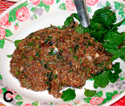
|
Thailand | Minced or finely chopped raw fish in spicy salad. The most popular raw fish dish in Isan. |
| Kokoda | 
|
Fiji | Appetiser or side dish of any white fish. A common staple. |
| Kuai | China | Finely cut strips of raw fish or meat, which was popular and commonly eaten in the early history and dynastic times of China. According to the Book of Rites compiled between 202 BCE–220 CE, kuai consists of small thin slices or strips of raw meat, which are prepared by first thinly slicing the meat and then cutting the thin slices into strips. In modern times, the dishes are more often referred to as "raw fish slices". Commonly used fish in ancient times include carp and mandarin fish, but salmon is also used in modern times. Sauces were an essential part of kuai dishes, with green onions used for preparation of sauces in spring and mustard seed used for sauces in autumn. According to many classical texts, kuai served without sauces was deemed inedible and should be avoided.[2] | |
| Lakerda | Turkey | Pickled bonito dish eaten as a mezze in the cuisines of the former Ottoman Empire. Lakerda made from one-year-old bonito migrating through the Bosphorus is especially prized. | |
| Lap pa Larb pla |
Laos Thailand |
ALao and Thai salad of raw freshwater river fish mixed with lime, cilantro, mint, scallions, roasted rice, chilis | |
| Lawa' Bale | South Sulawesi, Indonesia | Commonly associated with the Bugis people. The meal features fresh raw fish cured in vinegar and citrus juices, including bilimbi and unriped mango; as well as being spiced with grated coconut, garlic and chilies. | |
| Lomi oio | 
|
Hawaii | Finely minced or pureed raw fish mixed with salt. Seaweed, onions, limpets, shrimp, tomatoes, and chili are optional. |
| Namerō | 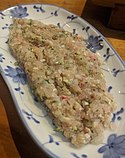
|
Japan, Bōsō Peninsula | Finely chopped raw fish mixed with spices and spread thin |
| 'Ota 'ika | 
|
Tonga | Raw fish dish typically made with coconut cream, tomatoes, lemon and spring onions. |
| Poke | 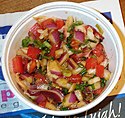
|
Hawaii | Raw fish salad |
| Sashimi | 
|
Japan | Sliced raw seafood. Dipped in soy sauce and wasabi before eating. |
| Soused herring (maatjes) | 
|
Netherlands | New season herring soaked in a mild preserving liquid |
| Stroganina | 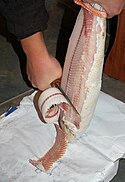
|
Russia | A dish of the indigenous people of northern Arctic Siberia made from raw thin sliced frozen fish.[3] |
| Tiradito | 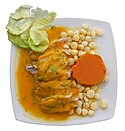
|
Peru | Variant of ceviche influenced by sashimi |
| Tuna tartare | 
|
Disputed | Minced raw tuna dish |
| Umai | Malaysia | A closely similar dish like the hinava, popular with the Melanau community in Sarawak. | |
| Xató or Xatonada | 
|
Catalan | Raw cod, anchovies and tuna fish with escarole, arbequinas olives, and "romesco" sauce. |
| Yusheng | 
|
Disputed | Raw fish salad |

Parasites in fish are a natural occurrence and common. Though not a health concern in thoroughly cooked fish, parasites are a concern when consumers eat raw or lightly preserved fish such as sashimi, sushi, ceviche, and gravlax. The popularity of such raw fish dishes makes it important for consumers to be aware of this risk. Raw fish should be frozen to an internal temperature of −20 °C (−4 °F) for at least 7 days to kill parasites. It is important to be aware that home freezers may not be cold enough to kill parasites.[8][9]
Traditionally, fish that live all or part of their lives in fresh water were considered unsuitable for sashimi due to the possibility of parasites (see sashimi article). Parasitic infections from freshwater fish are a serious problem in some parts of the world, particularly Southeast Asia.[citation needed] Fish that spend part of their life cycle in brackish or freshwater, like salmon are a particular problem. A study in Seattle, Washington showed that 100% of wild salmon had roundworm larvae capable of infecting people. In the same study farm raised salmon did not have any roundworm larvae.[10]
Parasite infection by raw fish is rare in the developed world (fewer than 40 cases per year in the U.S.[citation needed]), and involves mainly three kinds of parasites: Clonorchis sinensis (a trematode/fluke), Anisakis (a nematode/roundworm) and Diphyllobothrium (a cestode/tapeworm). Infection risk of anisakis is particularly higher in fishes which may live in a river such as salmon (sake) in Salmonidae or mackerel (saba). Such parasite infections can generally be avoided by boiling, burning, preserving in salt or vinegar, or freezing overnight. In Japan it is common to eat raw salmon and ikura, but these foods are frozen overnight prior to eating to prevent infections from parasites, particularly anisakis.
|
| ||
|---|---|---|
| Fish |
| |
| Shellfish |
| |
| Other seafood |
| |
| Processed seafood |
| |
| Seafood dishes |
| |
| Health hazards |
| |
| Advisory services |
| |
| Animal welfare |
| |
| Related topics |
| |
| ||
|
| |||||||||||||||||||||
|---|---|---|---|---|---|---|---|---|---|---|---|---|---|---|---|---|---|---|---|---|---|
| Dishes by origin |
| ||||||||||||||||||||
| By type and origin |
| ||||||||||||||||||||
| By type |
| ||||||||||||||||||||
| |||||||||||||||||||||